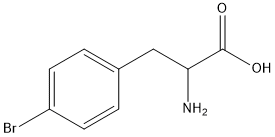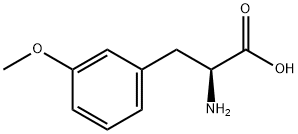DL-4-Chlorophenylalanine
Synonym(s):PCP;PCPA
- CAS NO.:7424-00-2
- Empirical Formula: C9H10ClNO2
- Molecular Weight: 199.63
- MDL number: MFCD00002601
- EINECS: 231-051-9
- SAFETY DATA SHEET (SDS)
- Update Date: 2024-12-18 13:37:16

What is DL-4-Chlorophenylalanine?
Chemical properties
Crystalline
The Uses of DL-4-Chlorophenylalanine
An irreversible tryptophan hydroxylase inhibitor.
The Uses of DL-4-Chlorophenylalanine
4-Chloro-DL-phenylalanine is an irreversible tryptophan hydroxylase inhibitor that depletes serotonin in the brain.
The Uses of DL-4-Chlorophenylalanine
4-Chloro-DL-phenylalanine has been used:
- as tryptophan hydroxylase 1 (TPH1) inhibitor to treat kras+ male zebrafish
- to induce insomnia in rat models
- used to treat embryos to examine its effect on serotonin
- for the selection of Enterococcus faecalis transformants with pESentA32 plasmid
- to feed flies to explore serotonin effect
What are the applications of Application
4-Chloro-DL-phenylalanine is an irreversible tryptophan hydroxylase inhibitor
Definition
ChEBI: 2-amino-3-(4-chlorophenyl)propanoic acid is a phenylalanine derivative.
Biological Activity
4-Chloro-DL-phenylalanine (Fenclonine, PCPA, CP-10188) is a selective and irreversible inhibitor of tryptophan hydroxylase, a rate-limiting enzyme in the biosynthesis of serotonin (5-HYDROXYTRYPTAMINE). 4-Chloro-DL-phenylalanine acts pharmacologically to deplete endogenous levels of serotonin.
Biochem/physiol Actions
4-Chloro-DL-phenylalanine (PCPA) is an inhibitor of 5-hydroxytrytamine (5-HT) synthesis. It helps to improve the inflammation of lung tissue and remodeling pulmonary artery. PCPA can reduce the expression of tryptophan hydroxylase 1 (TPH1), matrix metalloproteinase (MMP) and pro-inflammatory factors.
Safety Profile
An experimental teratogen. When heated to decomposition it emits toxic fumes of NOx and Cl-.
in vivo
4-Chloro-DL-phenylalanine(PCPA) markedly attenuates MCT(monocrotaline)-induced pulmonary vascular remodeling and lung inflammation, inhibits the expression of Tph-1 and SERT and suppresses the expression of MMP-2/-9, TIMP-1/-2, interleukin-1β (IL-1β), tumor necrosis factor-α (TNF-α) and intercellular adhesion molecule-1 (ICAM-1). PCPA inhibits 5-HT by suppressing Tph-1, regulating SERT and the serotonin downstream signaling pathway.
storage
Room temperature
Properties of DL-4-Chlorophenylalanine
| Melting point: | >240 °C (dec.)(lit.) |
| Boiling point: | 339.5±32.0 °C(Predicted) |
| Density | 1.2409 (rough estimate) |
| refractive index | 1.5790 (estimate) |
| storage temp. | room temp |
| solubility | Aqueous Acid (Slightly), Methanol (Slightly) |
| pka | pK1: 2.08(+1);pK2: 8.96(0) (25°C) |
| form | Powder |
| color | White to almost white |
| Water Solubility | slightly soluble |
| BRN | 2805758 |
| CAS DataBase Reference | 7424-00-2(CAS DataBase Reference) |
| EPA Substance Registry System | 4-Chlorophenylalanine (7424-00-2) |
Safety information for DL-4-Chlorophenylalanine
| Signal word | Danger |
| Pictogram(s) |
 Skull and Crossbones Acute Toxicity GHS06 |
| GHS Hazard Statements |
H301:Acute toxicity,oral H317:Sensitisation, Skin |
| Precautionary Statement Codes |
P280:Wear protective gloves/protective clothing/eye protection/face protection. P302+P352:IF ON SKIN: wash with plenty of soap and water. |
Computed Descriptors for DL-4-Chlorophenylalanine
New Products
Tert-butyl bis(2-chloroethyl)carbamate 4-Methylphenylacetic acid N-Boc-D-alaninol N-BOC-D/L-ALANINOL N-octanoyl benzotriazole 3-Morpholino-1-(4-nitrophenyl)-5,6-dihydropyridin- 2(1H)-one Furan-2,5-Dicarboxylic Acid DIETHYL AMINOMALONATE HYDROCHLORIDE 1,1’-CARBONYLDIIMIDAZOLE R-2-BENZYLOXY PROPIONIC ACID 1,1’-CARBONYLDI (1,2-4 TRIAZOLE) N-METHYL INDAZOLE-3-CARBOXYLIC ACID (2-Hydroxyphenyl)acetonitrile 4-Bromopyrazole 5-BROMO-2CYANO PYRIDINE 5,6-Dimethoxyindanone 5-broMo-2-chloro-N-cyclopentylpyriMidin-4-aMine 2-(Cyanocyclohexyl)acetic acid 4-methoxy-3,5-dinitropyridine 1-(4-(aminomethyl)benzyl)urea hydrochloride 2-aminopropyl benzoate hydrochloride diethyl 2-(2-((tertbutoxycarbonyl)amino) ethyl)malonate tert-butyl 4- (ureidomethyl)benzylcarbamate Ethyl-2-chloro((4-methoxyphenyl)hydrazono)acetateRelated products of tetrahydrofuran








You may like
-
 4-Chloro-DL-phenylalanine CAS 7424-00-2View Details
4-Chloro-DL-phenylalanine CAS 7424-00-2View Details
7424-00-2 -
 DL-4-chlorophenylalanine 98% CAS 7424-00-2View Details
DL-4-chlorophenylalanine 98% CAS 7424-00-2View Details
7424-00-2 -
 4-Chloro-DL-phenylalanine CAS 7424-00-2View Details
4-Chloro-DL-phenylalanine CAS 7424-00-2View Details
7424-00-2 -
 1975-50-4 98%View Details
1975-50-4 98%View Details
1975-50-4 -
 2-HYDROXY BENZYL ALCOHOL 98%View Details
2-HYDROXY BENZYL ALCOHOL 98%View Details
90-01-7 -
 14714-50-2 (2-Hydroxyphenyl)acetonitrile 98+View Details
14714-50-2 (2-Hydroxyphenyl)acetonitrile 98+View Details
14714-50-2 -
 118753-70-1 98+View Details
118753-70-1 98+View Details
118753-70-1 -
 733039-20-8 5-broMo-2-chloro-N-cyclopentylpyriMidin-4-aMine 98+View Details
733039-20-8 5-broMo-2-chloro-N-cyclopentylpyriMidin-4-aMine 98+View Details
733039-20-8